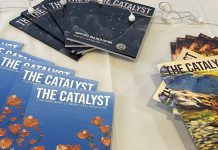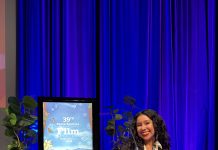
Soobin Lee
As University of California, Santa Barbara students, we’re surrounded by an ocean paradise, spoiled with unlimited access to beautiful, panoramic views of the sea and countless sunny afternoons spent on the beachside. However, to Brett McKim, a second year physics major from the College of Creative Studies, there’s far more to the ocean than what meets the eye.
McKim is an undergraduate research assistant working with the on-campus Marine Science Institute to study the ocean tides through tidal harmonic analysis, evaluating changes in sea pressure via oceanographic moorings in order to analyze the tidal forces and the mechanisms of the water’s movement.
With financial backing from the Coastal Fund, he placed pressure sensors at a depth of 15 meters that can detect the velocities of the water columns above. They are connected to buoys at the surface by lines that also record the temperature of the sea water.
In order to determine how ocean currents move, he must determine not only what velocity and direction the water is moving, but the forces influencing the movements as well. As such, observing pressure differences between different parts of the sea helps him to clue into what patterns exist in the ocean movements, and what’s causing them.
It’s intriguing work — and why else should we care about tidal harmonic analysis? According to McKim, having given talks at UCSB addressing school faculty on the subject (“Evaluating the Efficacy of Analytical Models of Gravity Currents” / “How Winds & Sea Level Differences Control Coastal Ocean Currents”), the answer is a matter of helping the environment.
“We have a lot of marine protected areas nearby, and these areas help establish breeding grounds for a lot of species in the Santa Barbara Channel,” he said as an explanation to how different oceanic species are not only interconnected with each other, but with the physical environment surrounding them.
“These currents are important to understand because they can bring in foreign nutrients or pollutants from other areas into these breeding grounds,” McKim said. “They can even transport fish larvae, pushing them away from these marine protected areas where they can settle into intertidal habitats, producing unpredictable environmental consequences.”
Many of these decisions affect UCSB students, and McKim believes that students should be “in tune” with their surroundings.
“Currents can also change the pH and oxygen levels of the ocean, and these types of changes need to be understood not just as random, but for the physical processes causing them — there are always reasons behind them,” McKim said. “So if you want to protect marine habits, you always want to know why we’re seeing these changes in the first place … this type of research helps inform coastal management that are seeking to preserve the biodiversity of the Santa Barbara Channel.”
In addition to his research, McKim has other aspirations lined up for his future.
“I’d like to get involved with climate change research, and right now, my research is a great opportunity to learn about the environmental consequences of climate change — like, right now I’m learning about ocean acidification — and I’m also just learning a lot from other professors and scientists at UCSB on their effects on marine communities,” McKim said. “Being a physics student, I like bringing this analytical background and physical intuition, and applying that to studying the climate because I care about the fate of the planet, and I’d like to at least have a role in helping out.”
And as to what he would recommend to other students hoping to get involved with research? To McKim, there are many opportunities for students to do research on campus if they put in the time and effort. Although it can be labor intensive and foreign to many undergraduates, it’s doable.
“If things weren’t hard, they wouldn’t be worth doing,” he said. “It’s really easy to get the impression that there’s no point in even trying because these challenges seem insurmountable — a long uphill climb. So it’s always important to remember what you’re trying to do in the first place: to discover what’s never been discovered before.”








Cool research going on as always
Comments are closed.